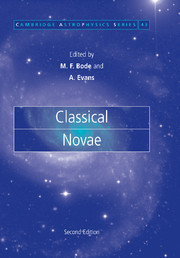Book contents
- Frontmatter
- Contents
- List of contributors
- Preface to the first edition
- Preface to the second edition
- List of symbols
- 1 Novae: an historical perspective
- 2 Properties of novae: an overview
- 3 The evolution of nova-producing binary stars
- 4 Thermonuclear processes
- 5 Nova atmospheres and winds
- 6 Observational mysteries and theoretical challenges for abundance studies
- 7 Radio emission from novae
- 8 Infrared studies of classical novae
- 9 Optical and ultraviolet evolution
- 10 X-ray emission from classical novae in outburst
- 11 Gamma-rays from classical novae
- 12 Resolved nebular remnants
- 13 Dust and molecules in nova environments
- 14 Extragalactic novae
- Object index
- Subject index
Preface to the second edition
Published online by Cambridge University Press: 10 October 2009
- Frontmatter
- Contents
- List of contributors
- Preface to the first edition
- Preface to the second edition
- List of symbols
- 1 Novae: an historical perspective
- 2 Properties of novae: an overview
- 3 The evolution of nova-producing binary stars
- 4 Thermonuclear processes
- 5 Nova atmospheres and winds
- 6 Observational mysteries and theoretical challenges for abundance studies
- 7 Radio emission from novae
- 8 Infrared studies of classical novae
- 9 Optical and ultraviolet evolution
- 10 X-ray emission from classical novae in outburst
- 11 Gamma-rays from classical novae
- 12 Resolved nebular remnants
- 13 Dust and molecules in nova environments
- 14 Extragalactic novae
- Object index
- Subject index
Summary
First conceived around 1981, the first edition of Classical Novae was published in 1989, after rather a long gestation period. This was at a time when the International Ultraviolet Explorer observatory was still going strong, the Hubble Space Telescope and the ROSAT X-ray observatory still lay in the future, and observatories that are now delivering data of stunning quality, such as Chandra, XMM and Spitzer, were still on the drawing board. Despite the comment in the preface to the first edition ‘had we kept to our original schedule the book would have become dated rather quickly’, Classical Novae dated very quickly, as was inevitable.
We had toyed with the idea of a second edition for some time. It was clear that tinkering at the edges of the first edition would not do: so much had changed since the publication of what we began to refer to as ‘CNI’. There were of course the inevitable advances in the quality and nature of the observations' over the entire electromagnetic spectrum, and in our theoretical understanding of the classical nova phenomenon as computing power grew. However, there was also the advent of the NASA Astrophysics Data System (ADS), and the facility to prepare a finding chart at the click of a mouse button (R. A. Downes & M. M. Shara 1989, PASP105, 127): who could have foreseen this when CNI was being compiled? The latter two rendered the Data on Novae chapter of the first edition completely obsolete.
- Type
- Chapter
- Information
- Classical Novae , pp. xivPublisher: Cambridge University PressPrint publication year: 2008



